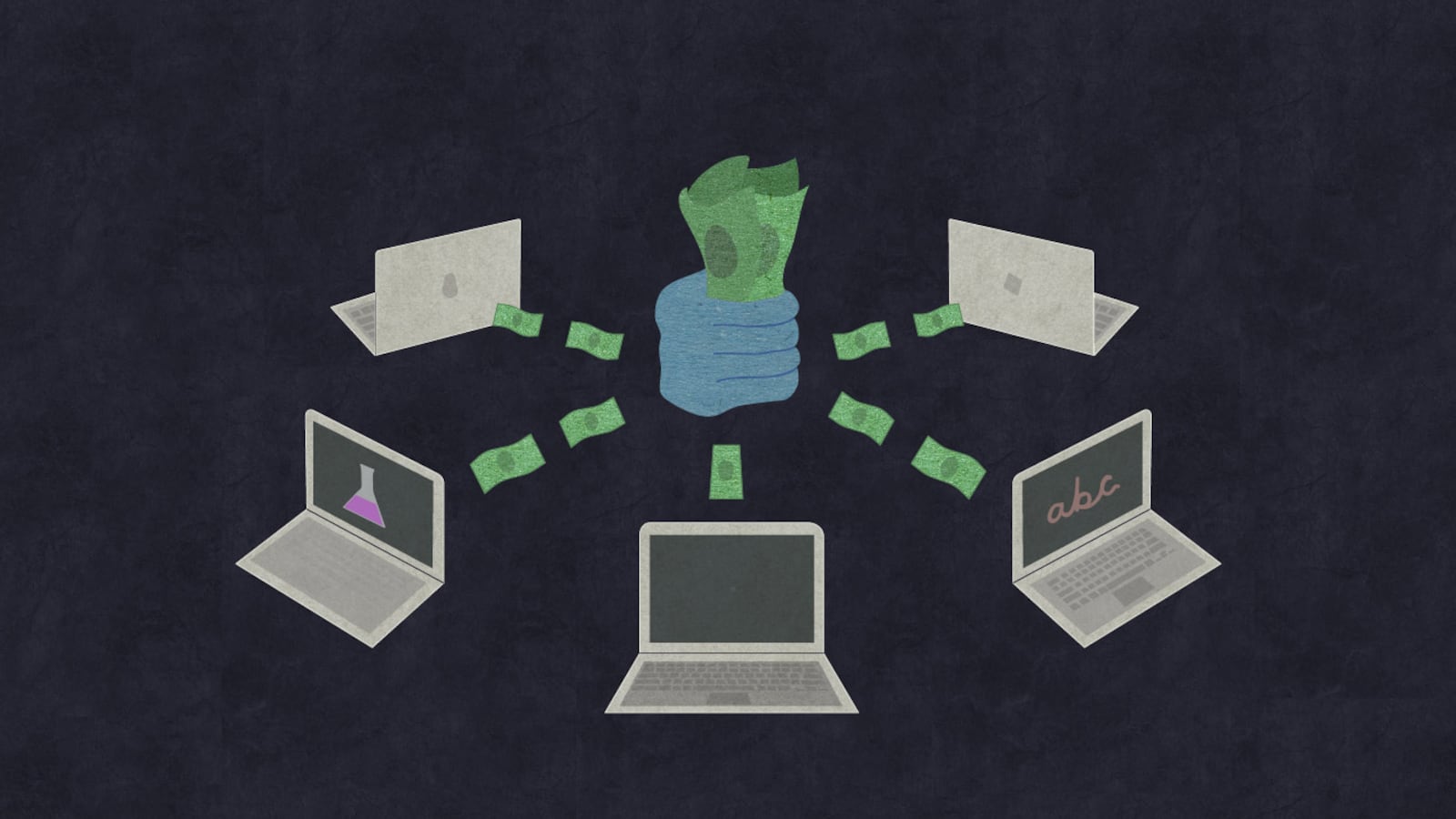One of Indiana’s largest high schools ended this past school year with almost 5,000 students, but no desks and no classrooms. The school also had very few graduates — 61 out of more than 900 seniors graduated last year.
What Indiana Virtual School did have: Tens of millions in state dollars due to come its way over the next two years, and a founder whose for-profit company charged millions of dollars in management fees and rent to the school.
Thomas Stoughton founded the school in 2011, taking advantage of a new law allowing Indiana charter schools to serve students exclusively over the internet, rather than in brick-and-mortar buildings.
In recent years, students have signed up in droves, responding to social media advertising campaigns. The school they end up attending differs widely from other online charter schools emerging across the country, with far fewer teachers per student — 1 for every 222 students last school year, according to state data — and fewer students taking and passing state exams.
As enrollment at Indiana Virtual School ballooned, so did the school’s state funding, which is distributed on a per-student basis. Some of that money has gone to AlphaCom Inc., a for-profit company also founded and led until June 2016 by Stoughton. From 2011 through mid-2015, AlphaCom held multiple contracts with Indiana Virtual School totaling about $6 million to provide management services and office space. A company run by Stoughton’s son also held a contract with the school.
AlphaCom’s involvement was necessary for Indiana Virtual School to launch and has now waned, according to the school’s lawyer, Thomas Burroughs. He said the school’s “innovative” approach offers a last chance to students who would have no other way to graduate. Burroughs also defended the school’s graduation rate and student-to-teacher ratio.
State education officials say they can’t intervene, and the tiny school district that oversees Indiana Virtual School has not pressed the school to improve until recently.
That leaves Indiana Virtual School operating with few checks in a state where lawmakers have pushed for an open education marketplace, with a wide menu of school options for families. In addition to schools run by traditional districts, the state also has charter schools, vouchers and tax-credit scholarships to help families pay for private school, and a new hybrid known as “innovation schools,” where charter school operators join forces with school districts.
Online charter schools, also known as virtual charter schools, are expanding quickly. Last year, more than 12,000 students across Indiana were enrolled in the schools, and that number is growing — a trend U.S. Education Secretary Betsy DeVos supports, but some researchers find concerning.
“For the vast majority of kids,” said Michael Barbour, a Touro University California professor who studies virtual charter schools, “the way in which we currently practice full-time online learning in the U.S. is a recipe for disaster.”
***
Indiana Virtual School did not respond to requests about exactly how it spends its money. However, financial documents that the school reports to the state suggest that it is using public dollars differently from other schools like it.
Indiana Virtual School’s most recent financial report, from the 2015-16 school year, shows that it received more than $9.7 million from the state that year. That figure is based on a state formula that awards online charter schools 90 percent of the funds per student sent to brick-and-mortar schools.
That year, Indiana’s two other major online charter schools spent about two-thirds of their state dollars on instruction, a category that includes programming, remediation, and salaries. Indiana Virtual School, by contrast, spent about 10 percent of its funding on instruction.

Yet the school directed 89 percent of its state funding toward “support services,” a catch-all category that can include essential supplies such as textbooks, as well as legal and administrative services or staff training. The two other online charter schools spent about a quarter of their budgets on support services.
Another big difference: the portion of Indiana Virtual School’s budget that went to teacher salaries. Indiana Virtual School spent 7 percent of its funding on teachers and other staff. That’s compared to 19 percent for Hoosier Academy Virtual and 28 percent for Indiana Connections Academy.
With a total of 21 teachers for 4,682 students according to state data, Indiana Virtual School had one teacher for every 222 students at the end of the last school year. Many of the teachers were only part-time, according to former teachers who spoke to Chalkbeat anonymously, saying they feared retribution from their former employer. Advertisements the school posted on the state education department’s jobs website earlier this year confirm the school sought part-time teachers.
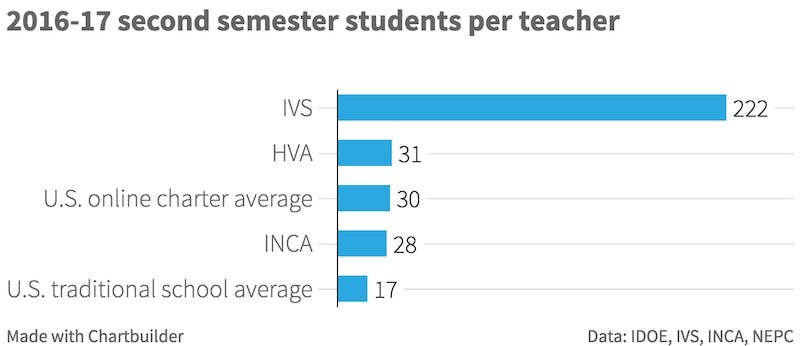
Asked about the school’s student-to-teacher ratio, Burroughs, Indiana Virtual School’s lawyer, provided updated figures for October 2017. He also disclosed a new development: As of August, Indiana Virtual School became two separate online charter schools, though they share the same principal and office address.
Between Indiana Virtual School and the new Indiana Virtual Pathways Academy, Burroughs said student enrollment surged to 6,332 since last school year. The number of teachers grew to 40, making the student-to-teacher ratio 158-to-1.
Either ratio far exceeds the 30-to-1 average at virtual schools nationwide, according to the National Education Policy Center, where researchers have studied virtual schools for years. The average ratio for brick-and-mortar schools was 17-to-1.
The school’s attorney said the current ratio is appropriate and suggested that schools with lower ratios are prioritizing the interests of educators, not children.
“The schools’ focus should be and is on helping students learn and graduate, and not on employing the maximum number of teachers deemed appropriate by teachers unions,” Burroughs said.
***
If Indiana Virtual spent such a small proportion of its funding on teachers, then where was the money going?
At least some of the school’s budget went to companies connected to the school’s founder.
Before launching Indiana Virtual School in 2011, Thomas Stoughton was involved in dozens of business ventures. He had worked in nonprofits, property management, consulting, public relations, finance, and higher education — but not as a K-12 educator.
His goal in opening Indiana Virtual School, he told Chalkbeat, was “to help and identify those kids over the years that, for whatever reason, the large educational system isn’t working for them.”
But Stoughton has combined his prior business experiences and Indiana Virtual School in a way that raises ethical questions.
Until last year, Stoughton chaired the school’s board while he was president of a for-profit company that the board hired to help manage the school. The company, AlphaCom, charged the school more than $2.5 million in “management services” between 2011 and mid-2015. The school also agreed to spend another $3.5 million between 2014 and 2023 to rent space in AlphaCom’s northern Indianapolis office park home.
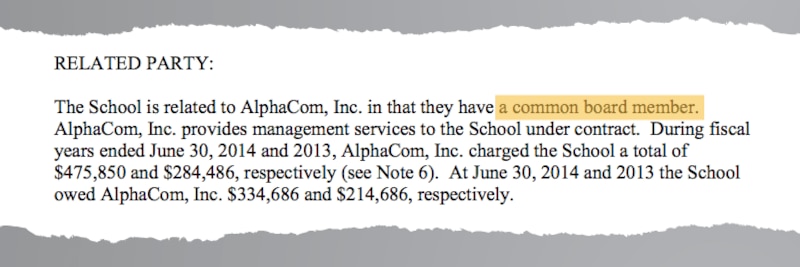
The school also was charged more than $500,000 in 2015 by a company headed by Stoughton’s son, also named Tom Stoughton, for technology and website design services. Other clients that the company, A Simple Reminder Inc., listed on a previous version of its website included Kickity Dragons, a local karate studio for toddlers, and a now-closed restaurant called Avec Moi.
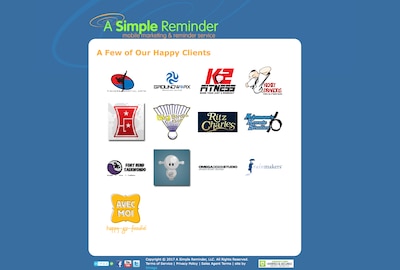
Burroughs said the relationship between the school and AlphaCom was appropriate, and the school could not have launched without them. Before the school opened, it had none of its own money and relied on the company to procure office space and buy essential supplies, he said, adding that Indiana Virtual School rented from AlphaCom because it could not obtain its own lease.
“Without AlphaCom,” Burroughs said, “the schools would not exist.”
IRS rules prohibit nonprofit leaders from individually benefiting from the organizations they run. And Indiana charter law requires that contracts disclose potential conflicts like the ones that set Stoughton’s company up to profit from the school’s spending.
“Violation of any of these federal or state laws could almost certainly be grounds for charter revocation,” said Amy Osborne of the Indiana Charter School Board, one of the state’s charter school authorizers.
It’s not clear whether Stoughton or Indiana Virtual School breached any laws. But none of the recent contracts provided to Chalkbeat identifies any possible conflicts of interest. And the original contracts between the school and AlphaCom — ones that were signed while Stoughton headed both entities — have been lost, according to Burroughs.
“Unfortunately, when Indiana Virtual School was audited for the 2015 audit report, the auditor took possession of the original of that agreement and numerous other agreements and never returned them,” Burroughs told Chalkbeat.
Burroughs, who also until recently sat on Indiana Virtual School’s board, said the school no longer contracts with A Simple Reminder. He also said Stoughton eliminated conflicts when he divested from AlphaCom in June 2016. Burroughs added more detail in October 2017, saying that Stoughton had recused himself from board votes related to AlphaCom and more recently had resigned from the board entirely, “now that the schools have a solid operating foundation.” Stoughton was a board member in September 2017, according to board minutes.
The school’s board never took issue with Stoughton’s overlapping roles or the fact that the school contracted to pay his company and his son’s, according to Stoughton. “Nobody has ever questioned it,” he told Chalkbeat in May. After that brief interview, he stopped responding to questions.
The school’s board has included several people with close personal ties to Stoughton: Founding board members James Tilford (who died earlier this year) and Thomas Krudy went to the same high school as Stoughton in the 1960s. Jeff Sparks, another founding board member, said he’s known Stoughton and his brother, Steve Stoughton, a former Indiana state representative, for 30 years.
***
Many of Indiana Virtual School’s students are a lot like Lexie DeVine: They have had difficulty succeeding in a traditional school setting.
DeVine started looking into online schools a couple years ago after dealing with bullying at her school in Perry Township. When she became pregnant with her daughter, that sealed the deal.
“That’s when I really decided, yeah, I think online school would be best,” DeVine, now 18, said. “I can hold my daughter with one hand and type with another.”
DeVine is the kind of student that Percy Clark, a longtime educator and Indiana Virtual School’s superintendent, said the school was designed to serve. About 85 percent of the school’s students are poor enough to qualify for meal assistance, and Clark said many have been expelled or dropped out from their previous school.
“When you see our kids and what they’ve gone through in terms of homelessness and pregnancy or drugs or abuse, and they’ve been able to get the Core 40 diploma,” Clark said, “that’s a chance for our state to celebrate.” The Core 40 diploma is Indiana’s primary high school diploma.
Burroughs, the school’s attorney, also said the school offers a safety net for students who have left other schools or been expelled.
“A diploma, or an enhancement of their skills may open doors and allow these ‘throw away’ students to become self-supporting, tax-paying citizens rather than welfare recipients or correctional facility residents,” he said.
But DeVine’s classmates largely aren’t graduating. The school had the lowest graduation rate in the state in 2016 at 5.7 percent. In 2017, Clark said, 61 of the more than 900 seniors earned diplomas.
DeVine said she hopes to graduate by the end of this year, though she’s still working on her junior year coursework. She started at Indiana Virtual School in February 2016 when she was 16.
"You’re essentially paying someone to teach someone who’s a ghost student."
a former English teacher
Many schools with needy students struggle to get them to graduation, but it’s unclear whether Indiana Virtual School has adopted practices that other schools have found can make a difference.
School officials say they are pursuing strategies that they think can help students learn. Burroughs pointed to an effort to help students who are not strong readers with a “text-to-speech” tool. He also mentioned a plan to begin “gamifying coursework,” which he said would “help students better learn and retain knowledge.”
But unlike some other virtual schools in Indiana and beyond, Indiana Virtual School says it does not provide students with free computers, an essential tool for accessing their schoolwork.
It also offers few organized ways for students to interact with each other. Some efforts appear to be underway: The school has recently posted on its website about a basketball program.
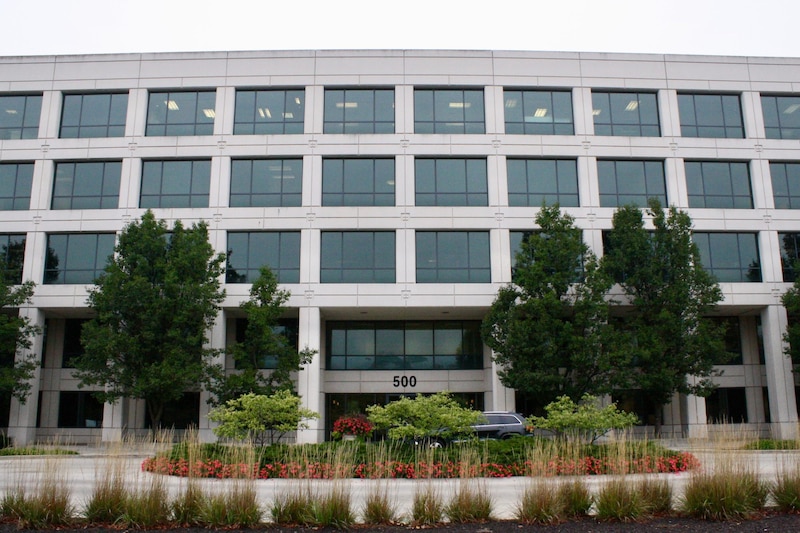
And its barebones teaching staff means students and teachers rarely connect in real time, leaving students on their own.
A science teacher who taught during the school’s early years said the lack of student interaction felt abnormal. She spoke about her experiences on the condition of anonymity.
“I found it very hard because I’m a very hands-on teacher, and I like to have that communication and contact with the students,” the former teacher said. “Not to have that, especially for the at-risk kids, was hard because those are the students who really need it.”
Unlike in other online schools, Indiana Virtual isn’t designed for teachers to give live lessons. They do not actively teach material to students whom they can see on video, hear over headphones, or chat via online messaging. Students work through class material on their own time, at their own pace, and contact their teachers only when they need or want to. Sometimes, teachers will follow up with check-ins for certain lessons.
Those conditions are challenging even for college students, said Gary Miron, a professor at Western Michigan University who researches virtual schools.
“We recognize at a university that even these mature students who can self-regulate and who are highly motivated” need to interact with their teachers, Miron said.
One signal that the school might not be paying close attention to student participation is its 100-percent attendance rate. The information it reports to the state is based only on whether students have signed up for courses, not whether they log in to do work, according to Clark and the teachers Chalkbeat spoke with.
If students do not make progress, the immediate downside for the school is minimal. And because Indiana law allows students to remain enrolled in school until they graduate no matter their age, Indiana Virtual School can continue to collect state funds while keeping costs low.
***
There is one group that is explicitly charged with stepping in if Indiana Virtual School does not fulfill its mission. That’s the school’s authorizer — the tiny, rural Daleville school district located near Muncie.
The Indiana State Board of Education is required to get involved once a school has four F grades in a row. So far, Indiana Virtual has received two failing grades.
Some authorizers have chosen to shut down poor-performing schools or made swift, substantial changes to improve them before the state intervened. But nothing in state law or regulation compels them to — an omission that drew recent criticism from federal authorities.
"We need a different A-F system ... Not only for virtual schools, but for other schools, especially those schools that have unique characteristics of students."
Percy Clark, Indiana Virtual School superintendent
Daleville has chosen to take a more passive role in spite of the school’s small teaching staff and low graduation rate and test scores. Last year, 20 percent of sixth-, seventh-, and eighth-grade students and 8 percent of 10th-graders at Indiana Virtual passed the English and math state tests. Statewide, about half of elementary and middle school students and one-third of high school students passed both exams.
Daleville’s top official said he feels that his hands are tied.
“I can’t say, ‘Do this!’ And you have to do it,” Daleville Superintendent Paul Garrison said. “You’ve got a death sentence you can use and nothing else.”
The charter authorizer system also contains a perverse incentive to keep low-performing schools open: Authorizers are paid by the schools they oversee.
Daleville collects 3 percent of Indiana Virtual’s funding from the state, although there’s disagreement among Indiana legal experts about whether districts that authorize charter schools should. In 2015-16, the district received just shy of $300,000. After the school’s enrollment spiked, Daleville was on track to receive more than $750,000 during the last school year.
In principle, those funds are supposed to defray the district’s costs of supervising the charter school. But it’s unclear exactly how that money fits into the district’s budget, which was about $9 million in 2016. Garrison said past years’ fees have gone toward salaries for staff working with the virtual school, computers, and online course fees for Daleville district students.
Some of the fees have gone toward working with the virtual school to design a new evaluation system for it. Daleville hopes the new system will be fairer than the state’s current approach to grading schools, which looks primarily at test scores and graduation rates.
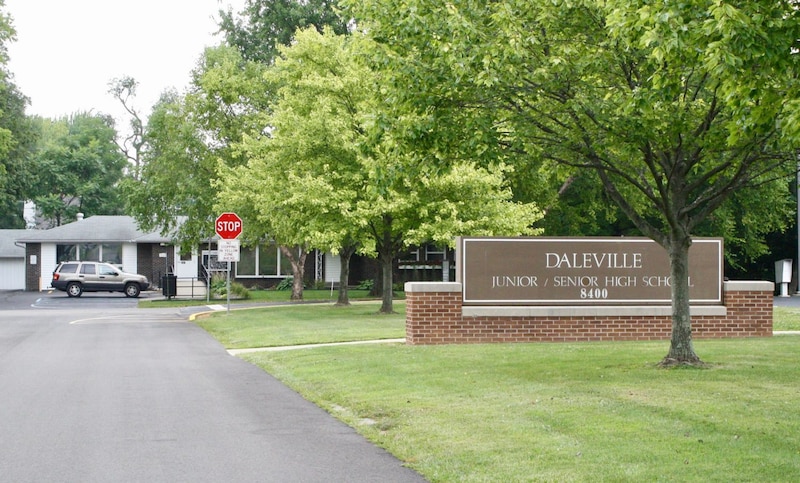
The district paid a Fort Wayne company, The Summit, $52,000 to design a model called “Evaluation of Online Learning and Virtual Efficacy,” or EVOLVE, which got an early test this summer.
“We need a different A-F system,” Clark said. “Not only for virtual schools, but for other schools, especially those schools that have unique characteristics of students.”
It’s too early to know if state officials will consider the alternative evaluation system. But there’s no question that even as poor results mount for online schools, Indiana officials are easing rules meant to hold virtual charters accountable for helping students learn.
The Indiana General Assembly this year passed bills that give even more leeway in how virtual schools are assigned A-F grades, calculate graduation rates, and expel students.
In 2017, every online charter school in Indiana received an F grade except for a hybrid school called Hoosier Academy-Indianapolis, where students attend some days in person and some days online. That school received a D this year, up from an F last year.
"If the policymakers don’t care and the citizens don’t apply pressure, then nothing can be fixed."
Diane Swanson, Kansas State University
State Superintendent Jennifer McCormick has long said that she is distressed by Indiana online schools’ performance.
But in an email to Chalkbeat, McCormick said the Department of Education, which she oversees, is not responsible for policing Indiana Virtual School — that falls to Daleville and, ultimately, the State Board of Education. McCormick, who also chairs the state board, has said authorizers need to get involved in virtual schools sooner, but she emphasized that’s not the education department’s call.
“The state does not equal the department when it comes to responsibility for policy,” she said. “Our role can be one of influence but is largely one of implementation of existing policies.”
While some state board members have joined McCormick in criticizing online charter schools, as a group they have consistently voted to let low-performing virtual schools stay open. The board chose not to close Hoosier Academy Virtual even though the school got seven years of F grades. Hoosier Academy’s own board voted last month to close at the end of this year because it feared repercussions from its authorizer, Ball State University.
Indiana Virtual School performed worse than Hoosier Academy, based on state data.
***
There’s one more group responsible for online charter schools in Indiana — lawmakers.
Virtual schools got a slow start in Indiana but took off once voters put a majority of Republican legislators in the General Assembly. Once there, they passed laws to allow full-time online schools and slowly increased their funding.
A number of powerful Indiana Republicans who supported those laws have received campaign contributions from K12, one of the largest online school providers in the country. That includes education committee chairs Rep. Bob Behning and Sen. Dennis Kruse, former Senate Appropriations chair Luke Kenley, House Ways & Means chair Tim Brown, and House Speaker Brian Bosma.
Kenley, who won’t be running for reelection in 2018, voted in 2011 to allow full-time virtual schools. But he has stopped proposals to increase virtual schools’ funding from making it into the state budget, and he wants his colleagues to think carefully about what they’re spending on online charter schools.
“Indiana is trying to be a leader and develop a platform with a lot of choices for a lot of different kinds of people,” Kenley said. “That’s a worthwhile pursuit, but you can’t shut your eyes and just throw money at things without the sense that success is being created there.”
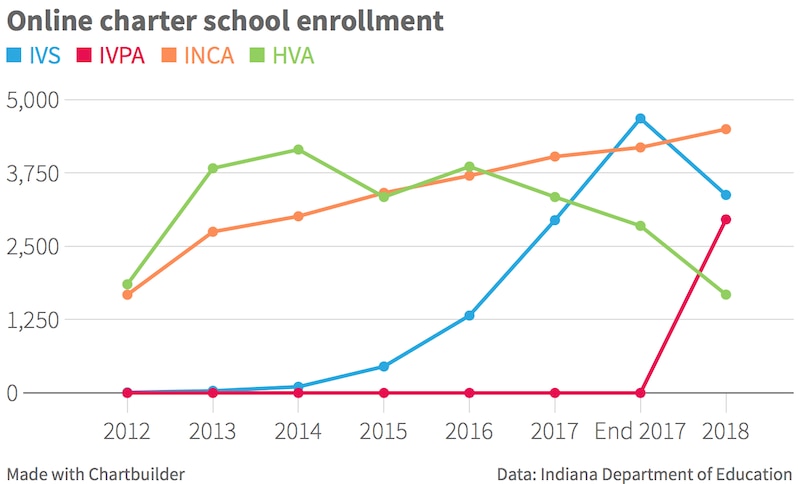
With the people who have the power to intervene at online charter schools allowing them to continue to grow unchecked, Indiana faces a perfect storm for problems to arise according to Diane Swanson, a Kansas State University researcher who studies government transparency and ethics.
“We can’t really rely on the people who are causing the conflicts of interest to fix it,” Swanson said. “If the policymakers don’t care and the citizens don’t apply pressure, then nothing can be fixed.”
***
For now, Stoughton appears to be oriented toward growth, not possible consequences. He and his colleagues at Indiana Virtual School are working to launch schools in Texas and Michigan, as well their second Indiana school, Indiana Virtual Pathways Academy.
The Texas Education Agency has not approved the charter for Texas Virtual School, but the Michigan Department of Education recently approved the charter for Michigan Online School, which would be authorized by the Gobles public school district. It is set to open in January.
Daleville officials authorized Indiana Virtual Pathways Academy to open in August. By Sept. 1, state records showed the school enrolled 2,958 students, 2,918 of whom came directly via Indiana Virtual School. The remainder came from 35 other schools across Indiana.
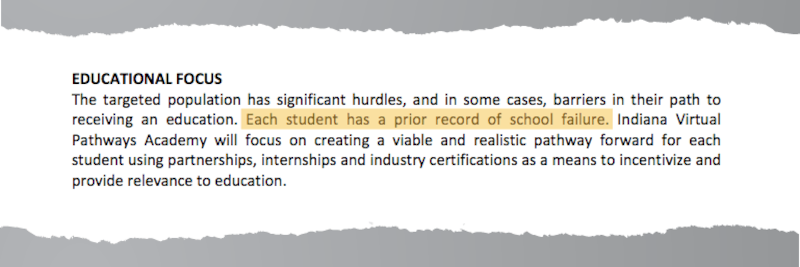
The school is billed as an alternative school, meant for students who struggle in a regular high school or have discipline issues. Alternative schools typically offer intensive services and support for students who would otherwise be at risk of dropping out.
Will Indiana Virtual Pathways offer those services even though Indiana Virtual has not? Clark, the school’s superintendent, did not respond to questions about the new school’s offerings for students. The school’s proposal for a new charter promises individualized “service plans” for each student, internship opportunities, and more support for needier students. But the proposal also names a “top end” of what the school’s student-to-teacher ratio can be: 250-to-1.
Even before Stoughton opened the second school, people with experience in education expressed concerns about what his ventures mean for students.
“It’s almost become a new business model for these groups, and they’re shortchanging kids in the end,” said Terri Austin, a Democratic state representative and former educator.
“How fair is it to kids when you know that some of these shady practices are going on and we turn a blind eye?” she added.
“Kids only get one chance.”
View document collection on DocumentCloud
This story has been updated to reflect the status of Michigan Online School.

